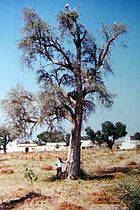pms
nòm ant ël fil


Tecomella undulata ist die einzige Art der Pflanzengattung Tecomella innerhalb der Familie der Trompetenbaumgewächse (Bignoniaceae). Das Verbreitungsgebiet reicht von der Arabischen Halbinsel bis ins westliche Indien.
Tecomella undulata ist ein meist halbimmergrüner Strauch oder meist ein kleiner Baum der bis etwa 5–10 Meter hoch wird. Die gräuliche Rinde kann unterschiedlich behaart sein. Die einfachen und kurz gestielten Laubblätter stehen gegenständig oder oftmals in Wirteln und sind eilanzettlich bis länglich geformt mit ganzem oft gewelltem Rand. Sie sind 5–12,5 Zentimeter lang und bis 3–3,5 Zentimeter breit, der Blattstiel ist bis 2–3 Zentimeter lang.
Die endständig an kurzen Zweigen stehenden Blütenstände sind Thyrsen, die wenige Blüten enthalten.
Die zwittrigen, großen und gestielten Blüten sind zygomorph und fünfzählig mit doppelter Blütenhülle. Der nicht haltbare, glockenförmige Blütenkelch endet in fünf Kelchzähnen. Die fünf orangefarbenen Kronblätter sind röhrig bis glockenförmig verwachsen und die Kronröhre endet in einem breiten Schlund. Die vier fertilen Staubblätter ragen über die Krone hinaus. Die Staubbeutel sind unbehaart, ihre Theken stehen auseinander. Neben den Staubblättern wird ein kürzeres Staminodium gebildet. Der oberständige Fruchtknoten ist länglich, feinschuppig besetzt und enthält eine Vielzahl an Samenanlagen. Er steht auf einem becherförmigen Diskus. Der Griffel ist lang mit zweilappiger Narbe.
Die linealischen, lederigen bis zu 34 Zentimeter langen Kapselfrüchte sind leicht vierrippig und besitzen flache Klappen. Die Samen sind elliptisch und beidseits mit einem dünnen Flügel versehen.
Tecomella undulata kommt vom südwestlichen Iran bis ins nordwestlichen Indien und in Oman vor.[1]
Die Erstveröffentlichung dieser Art erfolgte 1804 unter dem Namen (Basionym) Bignonia undulata durch James Edward Smith in Exotic Botany, 1, Seite 35. Die Gattung Tecomella wurde 1862 mit der Neukombination zu Tecomella undulata (Sm.) Seem. durch Berthold Carl Seemann in Annals and Magazine of Natural History, including Zoology, Botany, and Geology., Series 3, 10, Seite 30 aufgestellt.[1]
Tecomella undulata ist die einzige Art der Pflanzengattung Tecomella innerhalb der Familie der Trompetenbaumgewächse (Bignoniaceae). Das Verbreitungsgebiet reicht von der Arabischen Halbinsel bis ins westliche Indien.
रोहिड़ा या टेकोमेला उण्डुलता (इसका वानस्पतिक नाम (Tecomella undulata) है) राजस्थान का राजकीय पुष्प (१९८३ में घोषित) है। यह मुख्यतः राजस्थान के थार मरुस्थल और पाकिस्तान मे पाया जाता है। रोहिड़ा का वृक्ष राजस्थान के शेखावटी व मारवाड़ अंचल में इमारती लकड़ी का मुख्य स्रोत है। यह मारवाड़ टीक के नाम से भी जाना जाता है। शुष्क व अर्ध शुष्क क्षेत्रों में पाया जाने वाला यह वृक्ष पतझड़ी प्रकार का है। रेत के धोरों के स्थिरीकरण के लिए यह वृक्ष बहुत उपयोगी है।
Rohida - State Flower राजस्थान वन विभाग के आधिकारिक जालघर पर।
रोहिड़ा या टेकोमेला उण्डुलता (इसका वानस्पतिक नाम (Tecomella undulata) है) राजस्थान का राजकीय पुष्प (१९८३ में घोषित) है। यह मुख्यतः राजस्थान के थार मरुस्थल और पाकिस्तान मे पाया जाता है। रोहिड़ा का वृक्ष राजस्थान के शेखावटी व मारवाड़ अंचल में इमारती लकड़ी का मुख्य स्रोत है। यह मारवाड़ टीक के नाम से भी जाना जाता है। शुष्क व अर्ध शुष्क क्षेत्रों में पाया जाने वाला यह वृक्ष पतझड़ी प्रकार का है। रेत के धोरों के स्थिरीकरण के लिए यह वृक्ष बहुत उपयोगी है।
ఎడారి టేకు ను రాజస్తానీ టేకు అనికూడా పిలుస్తారు. దీని శాస్త్రీయ నామం Tecomella undulata. సారవంతం కాని ఇసుక నేలలో సైతం ఇంచుమించుగా ఎల్లప్పుడు పచ్చగా ఉండే చెట్టు ఇది.
Tecomella undulata is a tree species, locally known as rohida, found in Oman, and from southwest Iran to northwest India. It is the only species in the monotypic genus Tecomella.[1] It is a medium-sized tree that produces quality timber and is the main source of timber amongst the indigenous tree species of desert regions of Shekhawati and Marwar in Rajasthan. The trade name of the tree species is desert teak or Marwar teak.
Tree at the village of Harsawa
Tecomella undulata is a tree species, locally known as rohida, found in Oman, and from southwest Iran to northwest India. It is the only species in the monotypic genus Tecomella. It is a medium-sized tree that produces quality timber and is the main source of timber amongst the indigenous tree species of desert regions of Shekhawati and Marwar in Rajasthan. The trade name of the tree species is desert teak or Marwar teak.

Tree at the village of Harsawa

Leaves at the village of Gharsana, India

Trunk at Gharsana
Tecomella es un género monotípico de pequeños árboles o arbustos perteneciente a la familia de las bignoniáceas. Su única especie: Tecomella undulata, es originaria de Arabia, S. Irán, E. Afganistán, Pakistán y la India.
Árbol pequeño, que alcanza un tamaño de 2,5-5 m de altura. Hojas opuestas, enteras, lámina elíptico-oblongas a elíptico-lanceoladas o linear-oblongas, de 35-95 x (8-) 10-20 mm, margen ondulado, pecíolo de 6-18 mm de largo. Las inflorescencias en racimos condensados, 2-7-florecidas. Brácteas lineares, de 1.5-2 mm de largo, pubescentes estrellado; bractéolas 2, similar, de 1,5 mm de largo. Pedicelo 13-14 mm de largo. Flores, atractivas de color rojo anaranjado grande. Cáliz acampanado, 12-13 mm de largo, con 5 lóbulos desiguales; obtuso apiculado, minuciosa y escasamente glandular-pubescente. Corola tubo amplio en forma de embudo, dilatado en la base, lóbulos sub-orbiculares, de 20-25 x 28-32 mm. Los filamentos de los estambres más largos 37-38 mm de largo. Cápsula 17-34 x 0,9-1,2 cm, linear-oblongas, lateralmente comprimidas, ligeramente curvadas, ápice picuda con el ala, 20 mm de ancho.[1]
Tecomella undulata fue descrita por (Sm.) Seem. y publicado en Annals and Magazine of Natural History III, 10: 30. 1862.[1]
Tecomella es un género monotípico de pequeños árboles o arbustos perteneciente a la familia de las bignoniáceas. Su única especie: Tecomella undulata, es originaria de Arabia, S. Irán, E. Afganistán, Pakistán y la India.
Tecomella é um género botânico pertencente à família Bignoniaceae[1].
Tecomella é um género botânico pertencente à família Bignoniaceae.
Tecomella undulata là một loài thực vật có hoa trong họ Chùm ớt. Loài này được (Sm.) Seem. miêu tả khoa học đầu tiên năm 1862.[1]
Tecomella undulata là một loài thực vật có hoa trong họ Chùm ớt. Loài này được (Sm.) Seem. miêu tả khoa học đầu tiên năm 1862.